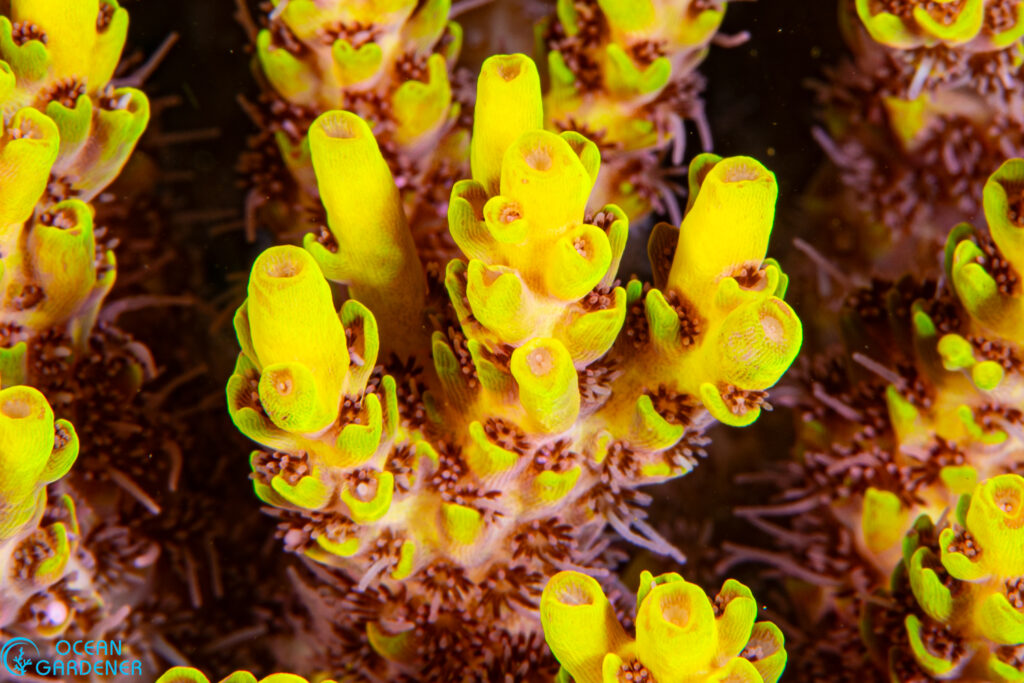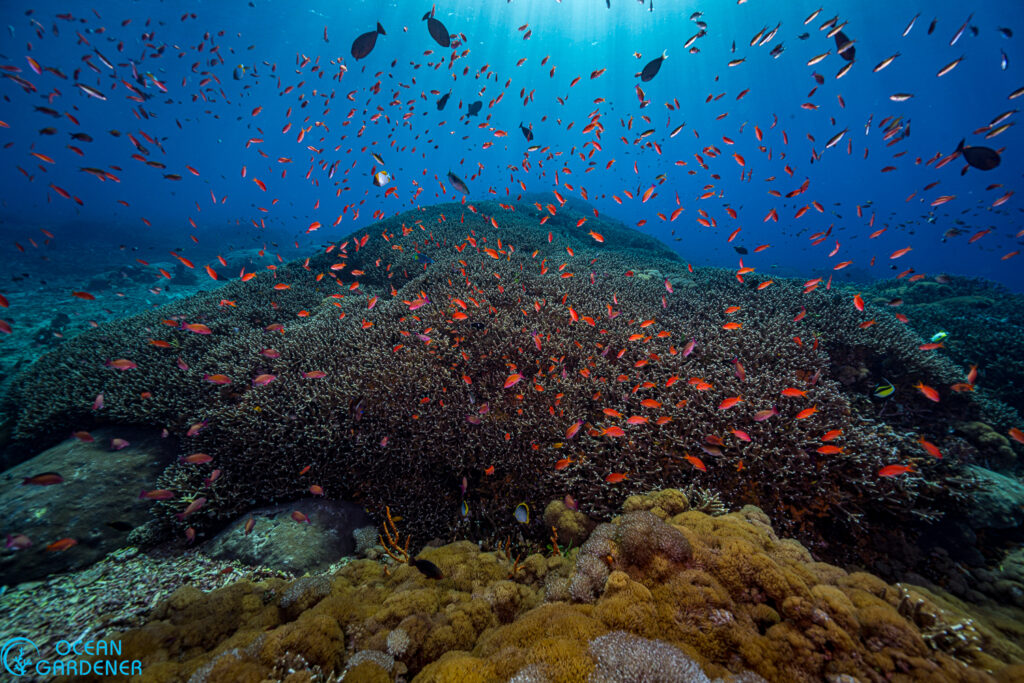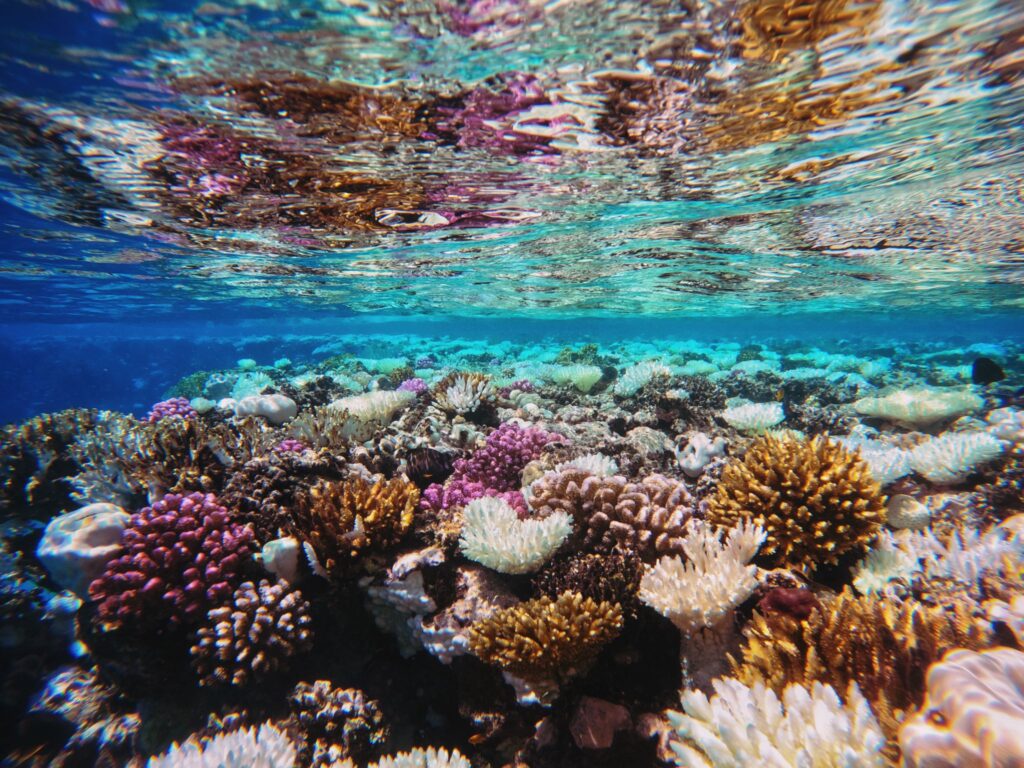Acropora is the largest genus of hard corals
Boasting an impressive diversity of 140 to 400 species, Acropora stands as the world’s most expansive genus of hard corals. While often characterized by their striking tabular or branching structures, their true uniqueness lies in the presence of specialized polyps: a leading axial polyp positioned at the very tip of each branch, guiding its outward growth, and numerous smaller radial polyps that populate the branch’s lateral surfaces. They dominate the shallow reefs but can also be found in the depths of 120m in the mesophotic zone.

Acropora play a very important ecological role
Acropora colonies are the bustling metropolises of the reef, providing indispensable habitat for an astonishing array of fish. Their complex, branching forms interlock to create thick, protective canopies and intricate labyrinths, serving as vital refuges and nurseries. From the tiny damselfish darting among their intricate branches to the imposing reef shark finding shelter beneath vast tabular formations, marine life utterly depends on these corals. Indeed, many larger species, such as juvenile groupers, snappers, and even certain reef sharks, begin their lives within these sheltered coral havens, relying on the intricate structure of Acropora for protection from predators as they grow. Without healthy Acropora, the very foundation of fish biomass crumbles – a stark reality where no Acropora means no fish.

Acropora coral have fast growth rates
Acropora corals are renowned as the fastest-growing genus of hard corals, boasting an impressive growth rate of up to 30 cm per year. This remarkable “superpower” is largely attributed to their highly efficient calcification process and their branching morphology. Their numerous growing tips allow for a rapid outward and upward expansion of their skeletal structure.
While Acropora prioritize rapid linear extension, their skeletons are generally less dense or more porous compared to slower-growing, massive coral species like Porites. Think of it like a trade-off: to grow quickly, Acropora builds a lighter, more open framework, depositing calcium carbonate primarily at the tips of its branches. This allows them to quickly colonize available space and compete for light. Conversely, massive corals, while slower, invest more energy into densifying their skeletons, making them more robust and resistant to physical damage. This difference in skeletal density is a key adaptive strategy.
Furthermore, like many corals, Acropora host symbiotic algae called zooxanthellae within their tissues. These algae efficiently photosynthesize, providing the coral with a significant portion of the energy needed for their accelerated growth and skeletal accretion.
This phenomenal growth rate is a critical asset because it enables their rapid structural development, which quickly creates the complex, three-dimensional habitats essential for a wide array of marine species. These intricate structures provide crucial shelter, nursery grounds, and foraging areas, allowing fish and other organisms to return, find refuge, and thrive in degraded reef areas. Thanks to this inherent capacity for rapid expansion, Acropora species are prominent features on healthy reefs throughout the Indo-Pacific (and historically in the Caribbean), defining these vibrant ecosystems by their sheer number of species and extensive coral cover.

Acropora is commonly used in coral restoration projects
Because Acropora are the fastest-growing and most common genus of hard corals, they are the primary species used in coral reef restoration. They act much like pioneer tree species in a deforested area, quickly establishing coral cover to initiate the restoration process. When the right species is carefully selected for a specific restoration site, these corals can be quite adaptable to slight environmental changes, offering a promising avenue for recovery.
However, it’s crucial to remember that in nature, every coral species is uniquely adapted to very particular environmental conditions. A common and significant mistake in coral reef restoration is planting the wrong species in the wrong place. This mismatch between the coral’s specific needs and the site’s conditions often leads to very poor results, undermining the entire restoration effort.

Acropora grows fast, at the cost of a weak immune system
Unfortunately, Acropora’s rapid growth comes with significant drawbacks. Their fast pace means a weaker immune system, making them highly susceptible to various diseases. Furthermore, their dominance on the reef makes them prime targets for specialized predators. These include the notorious coral-eating crown-of-thorns starfish (Acanthaster species), for whom Acropora is a favorite meal. Also once stressed, they attract Drupella snails, which also graze heavily on their tissues.
Beyond predation and disease, Acropora are not very aggressive competitors. While they can often outgrow slower-growing corals, cutting off their access to light and food, they typically lose battles for space against more aggressive species when placed side by side. For instance, if they encounter a highly aggressive coral like Galaxea, which possesses long, stinging sweeper tentacles, stinging Acropora and forcing it to recede. Hence special care needs to be taken when selecting and spacing species during coral restoration.

Acropora is susceptible to environmental changes
Despite their extraordinary growth rates, Acropora corals are highly specialized and adapted to thrive in waters with very low nutrient levels. This becomes a significant vulnerability when human activities, such as road run-off, agriculture, or untreated wastewater, lead to increased nutrient pollution. In these nutrient-rich environments, Acropora quickly lose out to other organisms like algae and sponges, which are better equipped to utilize the excess nutrients and can rapidly overgrow and smother the corals.
Adding to their fragility, Acropora are particularly susceptible to coral bleaching. This devastating phenomenon occurs when corals expel their symbiotic zooxanthellae (algae) due to environmental stressors, primarily elevated sea temperatures. While other corals can also bleach, the delicate, branching structures and specific physiological characteristics of Acropora make them among the first to succumb to thermal stress. Without their zooxanthellae, which provide the majority of their energy, the corals turn white and, if conditions do not improve, often starve and die, leading to rapid ecosystem degradation.
Their rapid growth also demands substantial quantities of minerals such as calcium, strontium, and carbonates for skeleton formation. However, rising water temperatures negatively impact the vital chemical reactions that facilitate this calcification process, making it less efficient. Furthermore, the calcification of their skeleton requires a high pH level to occur effectively. With ongoing ocean acidification, driven by increased atmospheric carbon dioxide, the fundamental task of building their intricate homes becomes increasingly difficult for Acropora.

The Decline of a Dominant Genus
Acropora corals, which have dominated shallow reefs for hundreds of millions of years, are now facing unprecedented threats due to human impact. Historically, these foundational species thrived, but their resilience is being pushed to its limits by a multitude of simultaneous pressures.
Direct human activities like anchor damage, discarded fishing nets, dynamite fishing, and plastic pollution immediately impact their physical structures. Compounding this, the widespread decline of apex predators such as sharks, groupers, Napoleon wrasse, and lobsters disrupts the natural balance of reef ecosystems. These predators naturally control populations of organisms that prey on corals, like the crown-of-thorns starfish and Drupella snails. Their absence leads to outbreaks of coral predators, further stressing Acropora populations.
Simultaneously, human activities are drastically altering the very chemistry of the ocean. Changes in nutrient composition from runoff, rising water temperatures, and decreasing pH due to ocean acidification create a perfect storm of environmental stressors. While corals are remarkably adaptable and can cope with individual challenges over time, the sheer number and rapid onset of these simultaneous threats are simply too much for Acropora to overcome.

Undiscovered Diversity on the Brink
Despite their widespread presence and adaptability to a broad range of habitats, shapes, and sizes, Acropora species are disappearing at an alarming rate. The urgency of this loss is magnified by the fact that many species remain undiscovered. With fewer than five Acropora taxonomists globally, and none currently in Indonesia, it’s highly probable that numerous species will vanish before we even have a chance to identify and describe them. The decline of coral reefs means a profound loss of biodiversity, much of which we may never even know existed.

Master the Complexity of Acropora Identification
With over 140 known species, Acropora is arguably the most complex coral genus to identify, a challenge so daunting it’s often informally called “coralphobia.” This significant knowledge gap directly impacts the success of coral reef restoration efforts worldwide. Understanding such an intricate genus, with its incredible diversity of shapes and colors, demands a robust methodology and expert guidance. Given that Acropora species are often the dominant corals on healthy reefs and foundational to reef recovery, mastering their identification is crucial for truly understanding both coral reef ecosystems and effective restoration practices.
Get advanced training in Acropora taxonomy with us
Ocean Gardener has developed a unique and comprehensive Acropora ID Coral Diver course. This program is the only one of its kind globally, meticulously designed to guide participants through the identification of over 90 Acropora species.
Our immersive 10-day course combines daily classroom sessions with 20 dives across various locations and habitats around Bali. This provides an unparalleled opportunity to observe each species firsthand in its natural environment, giving participants a unique advantage in memorizing their distinct characteristics and truly mastering Acropora identification.
